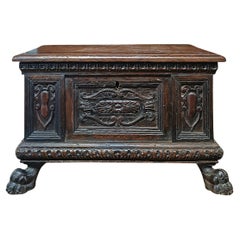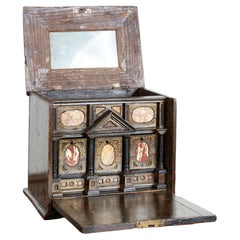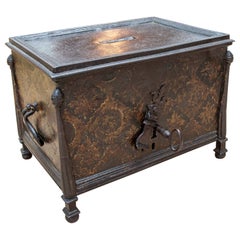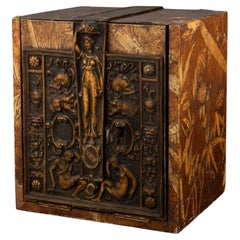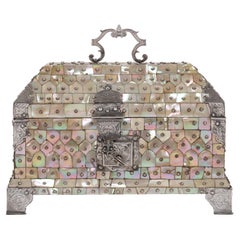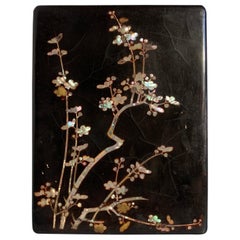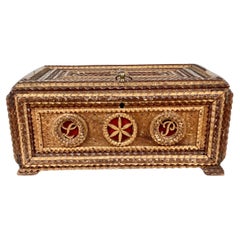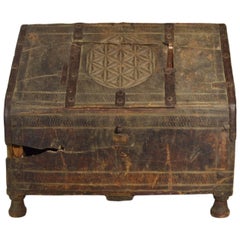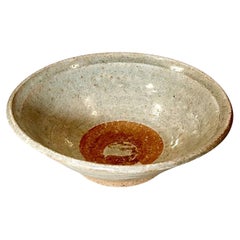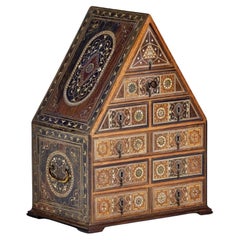16th Century Boxes
to
1
17
619
3,003
5,554
1,435
1,449
1,982
1,317
259
120
270
306
127
292
458
616
232
110
3
12
8
4
3
2
14
3
13
5
5
4
3
Height
to
Width
to
17
17
17
Period: 16th Century
LATE 16th CENTURY SMALL WALNUT BOX
Located in Firenze, FI
Elegant solid walnut small box, entirely hand-carved. The rectangular chest features an opening top, ideal for storing objects. The front, back, and sides are decorated with geometri...
Category
Italian Renaissance Antique 16th Century Boxes
Materials
Nutwood
Venetian Renaissance Jewelry Chest
Located in Greenwich, CT
Rare Venetian 16th century Italian traveling jewelry chest profusely decorated in Arabesque black and gilt decoration featuring rare specimen stone drawer fronts in a Palladian archi...
Category
Italian Antique 16th Century Boxes
Materials
Wood
16th Wrought Iron Safe, Renaissance Style, for Donations or Cash Chest
Located in Marbella, ES
Impressive wrought iron tabletop safe with engraved decoration and original patina. This type of safe was commonly used in the 16th and 17th centuries to hold valuables, alms, or doc...
Category
Spanish Antique 16th Century Boxes
Materials
Iron
Rare & Important 16th Century Italian Bronze Jacopo Lodovico del Duca Table Box
Located in Forney, TX
A magnificent antique fall-front box with scarce Medieval period bronze lockplate and hasp attributed to Jacopo and Lodovico del Duca.
Featuring an important Lockplate and Hasp designed circa 1570, exact date of manufacture unknown, attributed to the late 16th century Roman foundry of Jacopo 1520-1604) and Ludovico (1551-1601) del Duca, with no apparent signatures or hallmarks which is typical of the era, but we did not remove it and inspect the back.
Boxes such as this hand various uses but were frequently used by merchants as a writing box - slope during travel and trade, as a small coffer - strong box for storing important documents, money and valuables, as well as a jewelry casket.
This hand-crafted European drop-front box dates to the late 19th century, signed L'PUPLET, adorned with a significantly older Italian fine quality cast bronze lockplate with intricate Renaissance era reliefs, including figures, coat-of-arms, and elongated hasp, mounted on a chest of drawers form solid wooden case, wrapped in exotic Japanesque embossed and gilded metallic paper, having a locking fall-front panel with original key included, opening to reveal three interior drawers, all lined in red velvet. circa 1875
The visually striking textured wallpaper covering the box's exterior displays bamboo, birds, and flowers in the oriental Japanesque taste popular in Europe in the 1860s and 1870s following the forced reopening of foreign trade with Japan in 1858 and the ensuing Japonisme craze.
To the interior of the fall front panel is a gilt circular stamp with the somewhat obscured name of the workshop or store (likely) "L'PUPLET" and the city "Burxelles" which is in Brussels, indicating the box was likely made or retailed there.
Marks to box:
L'PUPLET, BRUXELLES
Inscription:
13, 14, 15 (Interior drawers inscribed on the verso of their backboards in script from top to bottom, respectively)
Provenance / Acquisition:
The origin of the elaborate lockplate with hasp on the front of the piece is more intriguing. At least 76 lockplates of this design have been recorded in major museums, private collections, and in the antiques trade across the Western World. For example, lockplates of this pattern are in the collections of the Rijksmuseum in Amsterdam, the State Museum of Prussian Cultural Heritage in Berlin, the Museum Cicico in Bologna, The Museum of Fine Arts in Boston, the Dallas Museum of Art in Texas, the Victoria & Albert Museum in London, the Museo di Palazzo Venezia in Rome, the State Hermitage Museum in St. Petersburg, and the National Gallery of Art in Washington, DC.[1]
Specialists in Renaissance bronzes, especially Charles Avery...
Category
Italian Japonisme Antique 16th Century Boxes
Materials
Bronze, Metal
16th-Century Indo-Portuguese Colonial Mother-of-pearl Gujarat Casket
Located in Amsterdam, NL
An exceptional Indo-Portuguese colonial mother-of-pearl veneered casket with silver mounts
India, Gujarat, 2nd half of the 16th century, the silver mounts Goa or probably Lisbon
Measures: H. 16 x W. 24.6 x D. 16.1 cm
An exceptional Gujarati casket with a rectangular box and truncated pyramidal lid (with slopes on each side and a flat top) made from exotic wood, probably teak (Tectona grandis), covered with a mother-of-pearl mosaic. The tesserae, cut from the shell of the green turban sea snail (Turbo marmoratus, a marine gastropod) in the shape of fish scales, are pinned to the wooden structure with silver ball-headed nails. The casket is set on bracket feet on the corners. The masterfully engraved decoration of the silver mounts follows the most refined and erudite Mannerist repertoire of rinceaux and ferroneries dating from the mid-16th century. The high quality and refinement of the silver mounts and, likewise, the silver nails that replaced the original brass pins used to hold the mother-of-pearl tesserae in place indicate the work of a silversmith probably working in Lisbon in the second half of the 16th century.
The Indian origin of this production, namely from Cambay (Khambhat) and Surat in the present state of Gujarat in north India, is, as for the last three decades, consensual and fully demonstrated, not only by documentary and literary evidence - such as descriptions, travelogues and contemporary archival documentation - but also by the survival in situ of 16th-century wooden structures covered in mother-of-pearl tesserae. A fine example is a canopy decorating the tomb (dargah) of the Sufi saint, Sheik Salim Chisti (1478-1572) in Fatehpur Sikri in Agra district in the state of Uttar Pradesh, north India. This is an artistic production, geometric in character and Islamic in nature, where usually the mother-of-pearl tesserae form complex designs of fish scales or, similar to the dishes also made using the same technique, with the thin brass sheets and pins, stylized lotus flowers. The truncated pyramidal shape corresponds, like their contemporary tortoiseshell counterparts also made in Gujarat, to a piece of furniture used in the Indian subcontinent within the Islamic world prior to the arrival of the first Portuguese. This shape, in fact, is very old and peculiar to East-Asian caskets, chests or boxes used to contain and protect Buddhist texts, the sutras.
A similar chest is the famous and large reliquary chest from Lisbon cathedral that once contained the relics of the city's patron saint, Saint Vincent. Both match in shape, having the same kind of socle or pedestal and bracket feet, and in their engraved silver mountings, featuring the same type of refined, erudite decoration. Their differences lie in the silver borders that frame the entire length of the edges of the chest (both the box and the lid), pinned with silver nails, and on the lock plate, shaped like a coat of arms in the Lisbon example. Given the exceptional dimensions of the reliquary casket...
Category
Indian Antique 16th Century Boxes
Materials
Silver
Japanese Momoyama Period Black Lacquer and Mother of Pearl Box, 16th Century
Located in Austin, TX
A fine and unusual Japanese black lacquer and mother of pearl inlaid box, Momoyama Period, 16th century, Japan.
The large box and cover featu...
Category
Japanese Edo Antique 16th Century Boxes
Materials
Lacquer, Abalone
Chest. Carved wood, metal. Spanish school, 16th century.
Located in Madrid, ES
Chest. Carved wood, metal. Spanish school, 16th century.
Rectangular casket with a flat lid decorated on the outside with a series of figurative reliefs in a symmetrical arrangemen...
Category
Spanish Renaissance Antique 16th Century Boxes
Materials
Metal, Other
Large Japanese Namban Lacquer Coffer Arqueta, 16th Century
Located in Amsterdam, NL
A large Japanese Namban lacquer arqueta coffer for the Portuguese market
Kyoto, Momoyama-period, late 16th century
In Hinoki cypress lacquered in ...
Category
Japanese Antique 16th Century Boxes
Materials
Mother-of-Pearl, Wood
Superb Late 16th Century Signed Colonial Japanese Namban Export Lacquer Coffer
Located in Amsterdam, NL
Superb late 16th century signed colonial Japanese Namban export lacquer coffer
Momoyama period, late 16th/early 17th century, inscribed 'Arisato' on the bottom
H. 30.5 x W. 43...
Category
Japanese Antique 16th Century Boxes
Materials
Cedar, Lacquer
Hostiary. Bronze. 16th century.
Located in Madrid, ES
Hostiary. Bronze. 16th century.
A circular, tubular bronze box with a finial lid, to which a piece of tubing is attached, forming a press for the interior of the case. It features a...
Category
European Other Antique 16th Century Boxes
Materials
Bronze
Important Renaissance Medical Box Spanish or Italian Workshop, Around 1550
Located in Madrid, ES
Important Renaissance Medical Box. Spanish Or Italian Workshop, Around 1550
Renaissance Medical Casket with stepped lid and vaulted flanked dome. Polychro...
Category
Spanish Baroque Antique 16th Century Boxes
Materials
Wood
Spanish Renaissance Casket of the 16th Century
Located in Madrid, ES
Spanish Renaissance casket,
16th century
In carved, polychrome and gilded wood decorated with a vase with horns of plenty, heads of cherubs and fruits.
In the lock a shield with two ...
Category
Dutch Baroque Antique 16th Century Boxes
Materials
Wood
Antique 16th century Venetian Painted Gold Gilt Iron Strongbox with Original Key
Located in Doha, QA
An extraordinarily rare and visually striking 16th-century Venetian iron treasure coffer, showcasing the height of Renaissance artistry and engineering. Crafted in the early to mid-1...
Category
Italian Renaissance Antique 16th Century Boxes
Materials
Gold, Iron
Rare 16th Century Nuremberg Box
Located in Madrid, ES
Rare 16th century Nuremberg box
In iron, measurements: 13 x 18 x 12 cm
Good condition.
Category
German Baroque Antique 16th Century Boxes
Materials
Iron
Chest, Leather, Wrought Iron, Textile, Wood, Spain, circa 1500
Located in Madrid, ES
Rectangular body casket with semicircular lid made of carved wood and covered with a worked leather that has been reinforced with a series of forged iron fittings, material in which ...
Category
Spanish Gothic Antique 16th Century Boxes
Materials
Wrought Iron, Other
Small Gilded Box Engraved and Painted Wood Venice Italy XVI C. Belloni family
Located in Milano, IT
Small box with opening top, slightly convex urn front with shaped shelf support, decorated on the front with carved tablet, while the rest of the object is simply painted. The front started with four pilasters that create three reserves, the two lateral pilasters have two twisted columns on a blue background, the central pilasters are instead painted with gold candelabra...
Category
Italian Other Antique 16th Century Boxes
Materials
Wood
$17,593 Sale Price
20% Off
Spanish Mudejar-Style Wooden and Leather-Covered Chest, circa 1500
Located in Marbella, ES
Mudejar-style chest. Spain, circa 1500.
Wood and leather.
A chest with a wooden core and leather lining. The leather has been embossed with stylised vegetal motifs on both sides, i...
Category
Spanish Antique 16th Century Boxes
Materials
Leather, Wood
Related Items
Late 19th Century Tramp Art Box
Located in Bradenton, FL
Vintage late 19th century Tramp Art Box inset with mirror and fabric. "Tramp Art" objects began in the 1870s, driven by the abundance of wooden cigar boxes and their availability to ...
Category
American Folk Art Antique 16th Century Boxes
Materials
Textile, Wood
Antique Indian Mughal Wood Dowry Chest with Carved Patterns, 19th Century
Located in Yonkers, NY
A 19th century Mughal dowry chest with carved patterns from India. This chest wooden chest with a slanted top strengthened by metal hardware reinforcements. The front displays lightly carved geometrical friezes. A large carved geometrical medallion adorns the triangular lid. The chest rests on four conical legs. This chest opens thanks to an door on the centre of its top. This unusual item was used as a dowry chest in India. This 19th century, Indian Mughal wood dowry chest...
Category
Indian Antique 16th Century Boxes
Materials
Wood
$590
H 14 in W 11 in D 16 in
Indian 19th Century Box with Metal Sheathing and Bracketed Wooden Base
Located in Yonkers, NY
An Indian antique box from the 19th century with metal sheathing and bracketed base. Created in India during the 19th century, this antique box features a linear silhouette made of m...
Category
Indian Antique 16th Century Boxes
Materials
Metal
$750
H 8 in W 17.25 in D 12.5 in
18th Century Wrought Iron Italian Antique Hobnail Safe Strong Box Bar Cabinet
Located in Carimate, Como
Beautiful and rare example of late 18th century Italian master blacksmith craftsmanship, this antique studded safe with typical all-around hobnails and great wrought iron details, pr...
Category
Italian Baroque Antique 16th Century Boxes
Materials
Metal, Wrought Iron
$6,538
H 23.63 in W 23.23 in D 11.03 in
Indochinese Box in Wood and Mother of Pearl circa 1900
Located in Beuzevillette, FR
Nice wooden and mother-of-pearl box from the 1900s. The mother-of-pearl inlays form plant motifs (flowers and foliage), incised to give volume to the different parts. It closes with ...
Category
Asian Antique 16th Century Boxes
Materials
Wood
Japanese Lacquer Hokai Box, 19th Century
Located in Pasadena, CA
This is a good example of a traditional Japanese Hokai shell storage box for the Kai-awase game. This box is well-detailed in chased brass appliques and makie. The box is in overall ...
Category
Japanese Japonisme Antique 16th Century Boxes
Materials
Wood, Lacquer
Antique Handmade Wood Money Box with Hardware from 19th Century, China
Located in Yonkers, NY
An antique handmade Chinese money box with metal hardware from the 19th century. This rectangular box is made of two-tone wood. The front displays a ...
Category
Chinese Antique 16th Century Boxes
Materials
Brass
Japanese Rinpa Style Lacquer Box Meiji Period
Located in Atlanta, GA
A black lacquer tebako (hand box) with maki-e decoration and silver trim, circa late 19th century, Meiji period. The surface of the lid features a Rinpa style maki-e paint depicting ...
Category
Japanese Japonisme Antique 16th Century Boxes
Materials
Wood, Lacquer
19th Century Indian Malabar Dowry Jewelry Box in Lacquered Teak with Handcrafted
By Rajhastani
Located in North Hollywood, CA
Antique South Indian Malabar Dowry Jewelry Box, 19th Century Teak with Brass – Kerala, India
A rare and collectible South Indian dowry box from Kerala...
Category
Indian Agra 16th Century Boxes
Materials
Brass
$1,950
H 11 in W 14 in D 11 in
Small Italian Florentine Jewelry Miniature Chest of Drawers
Located in Haddonfield, NJ
This vintage gilt wood storage or jewelry box features one drawer and flip up top with mirror. with storage below lined in an orange velvet fabric. The box has has lots of character,...
Category
Italian Mid-Century Modern 16th Century Boxes
Materials
Giltwood, Paint, Fabric, Velvet
Japanese Meiji Period Antique Lacquer Box with Gold Maki-e Decoration
Located in New York, NY
A fine antique Japanese Meji Period lacquer box decorated with a fan and a stylized star shaped window in the maki-e technique. The fan at the top right corner, fully opened depictin...
Category
Japanese Meiji Antique 16th Century Boxes
Materials
Lacquer
$1,700
H 4.5 in W 3.25 in D 1.88 in
Late 19th Century Bronze Box - Putti - Renaissance Style
Located in Casteren, Noord-Brabant
A beautiful bronze box, decorated in renaissance style with putti and decorative ornaments.
The box is in good condition, key is missing. Beautiful colour and patina.
Dimensions: ...
Category
French Renaissance Antique 16th Century Boxes
Materials
Brass, Bronze
Previously Available Items
Korean Joseon Dynasty Bowl
Located in Tampa, FL
A Korean Joseon Dynasty glazed ceramic bowl. It is a celadon color. The Joseon Dynasty, circa 1392-1897.
Category
Korean Antique 16th Century Boxes
Materials
Porcelain
RARE PORTUGUESE CENTER CHAPEL COUNTER 16th Century
Located in Madrid, ES
RARE CENTER CHAPEL COUNTER 16th Century
Lusíada - Portuguese in teak,
Partial sissoo coating with ivory inlays, with 9 drawers simulating 10.
Micromosaic in different materials, bac...
Category
Portuguese Gothic Antique 16th Century Boxes
Materials
Wood
Iron Cassette with Keys and chased Decor, Nuremberg around 1580
Located in Greding, DE
Rectangular box with hinged lid on ball feet.
It has slight damage, the lid for the key opening is missing.
Category
German Renaissance Antique 16th Century Boxes
Materials
Iron
Florentine Leather Casket, 16th Century
Located in Bruxelles, BE
Florentine leather casket
Italy, Tuscany
16th century
leather, iron and wood.
Very rare boiled leather box incised on a wooden core; iron lock.
The central shield is divide...
Category
Italian Renaissance Antique 16th Century Boxes
Materials
Iron
Northern Italy Box Set with 16th Century Floral Motifs
Located in Madrid, ES
Northern Italy box set with 16th century Floral Motifs
18.5x30x16cm
Casket in carved and gilded wood with floral motifs.
Sealing wax stamp inside.
Vintag...
Category
Italian Gothic Antique 16th Century Boxes
Materials
Wood
Rare and Beautiful 16th Century Siena Box
Located in Madrid, ES
Rare and Beautiful 16th century Siena box
13cm x 15.5cm x 27cm
Paper mache box gilt and lacquered in blue and red.
Good condition for the age.
Category
Italian Gothic Antique 16th Century Boxes
Materials
Wood
Pinyonet or "Rice Grain" Marquetry Chest, Spain, 16th Century and Later
Located in Madrid, ES
chest. Wood, bone inlay, iron. Spain, possibly Catalan or Aragonese school, 16th century (with later restorations).
Rectangular casket with a flat lid that closes at the front by m...
Category
Spanish Renaissance Antique 16th Century Boxes
Materials
Other
H 9.45 in W 23.63 in D 15.75 in
Pyx. Carved and Polychrome Wood, Spanish School, 16th Century
Located in Madrid, ES
Pyx. Carved and polychrome wood. Spanish school, 16th century.
Box with a circular base and a frustoconical body that has a vaulted lid topped with a knob with a molding, it is made of carved wood and preserves traces of gilding on its outer surface and also on the interior (lid and base). In this area it is decorated with some vegetable-themed carvings on the lid and winged angel heads joined by curved textiles reminiscent of garlands on the front of the body. Typologically, the shape of the piece is reminiscent of silver pyxes...
Category
Spanish Renaissance Antique 16th Century Boxes
Materials
Other
Late 16th Century Jewelry Chest
Located in Saint-Ouen, FR
Provenance : Jean Gismondi collection, before 1973.
This important walnut jewelry chest is outlined with a gilt motif and presents a decor imitating basketry. The lid is topped by...
Category
Italian Renaissance Antique 16th Century Boxes
Materials
Walnut
Elizabethan 16th Century Diminutive Cedar Wood Table Casket/Cabinet or Desk Box
Located in Oxfordshire, United Kingdom
The late 16th century Elizabeth I Diminutive Cedar wood table casket or desk box, Circa 1600. England.
The raised and moulded top slides open to reveal a recessed well.
The entire moulded 'caddy' with applied edge-mouldings to all faces opens on strap hinges to a box interior exposing an internal sliding peg to the lockable sliding panelled frieze with pyramid centres, concealing four small drawers around a central deeper drawer above a long drawer, all with edge mouldings and turned handles. Raised on an intricately moulded base and raised on what is believed to be all of the original reeded bun feet.
It should be noted - Caskets of this form from the Elizabethan period are extremely rare.
This casket is one of the most accomplished and original examples to be discovered. The colour and patination of the original surfaces are outstanding. Sensational.
Literature: For a comparable inlaid table...
Category
Antique 16th Century Boxes
Materials
Cedar, Oak
H 16.15 in W 15.75 in D 9.85 in
Eucharistic Chest, Carved and Polychrome Wood, Spain, 16th Century
Located in Madrid, ES
Chest. Carved and polychrome wood. Spain, 16th century.
Carved wooden casket, gilded and polychrome with a rectangular base and upper part in the shape of a gabled roof or trough (with straight and not inclined smaller sides); It opens when lowering the front panel, revealing the polychrome and the gilding of the interior. On the outside, the piece presents a painted decoration: on the smaller sides two male figures on a gold background flanked by fine balustraded columns and under a decoration reminiscent of cloth; the front has simple architectural elements carved in slight relief, leaving the semicircular arch for a Virgen de la Leche; the back has a composition based on vegetal elements in "ce", scrolls, winged children, masks, scrolls, etc., with a clear classicist influence;
The upper part of the piece has a decoration similar to that of the background on all fronts except the front, where you can clearly see an inscription in Latin capital letters inspired by Antiquity framed by a band with scrolls and vegetal elements. On the sides are Saint Peter with the keys and Saint Paul holding in his arms the sword that alludes to his martyrdom. Both the faces and the postures of the characters and the architectural elements show a clear relationship with stylistic novelties, while the golden background is a common detail in the Spanish schoolsince the Gothic. Decoration based on plant elements, scrolls, etc. present in several areas of the casket, which has already been mentioned, it is known as grutescos, and stands out for its classicist influence, for not presenting a strictly symmetrical organization in all the panels in which it is found, and for its compositional quality. The grotesque is a very common decorative motif in art since the "discovery" (XV century) in the Domus Aurea of Rome of ancient paintings with vegetal elements, cornucopias, panoplies, human and theriomorphic figures, mythological beings, etc. arranged in usually symmetrical compositions. The Virgin Mary is presented nursing the Child, hence this iconography is known as the Virgin of the Milk. Regarding the inscription (“O SACRV CONBIBIVM IN QUO XR [CRISTO] / SVMITVR RECOLITVR MEM / RIA PASSIONIS EIUS MENS INP”) distributed in three lines, it is a prose text in Latin in which the Blessed Sacrament is honored, written by Saint Thomas...
Category
Spanish Renaissance Antique 16th Century Boxes
Materials
Other, Gold Leaf
Small 16th Century Italian Renaissance Walnut Cassone or Marriage Chest
Located in Middleburg, VA
The beautiful 16th century Italian renaissance cassone or marriage box with its rare small size will make a lovely addition to your de...
Category
Italian Renaissance Antique 16th Century Boxes
Materials
Walnut
Recently Viewed
View AllMore Ways To Browse
Carved Ivory Bird
Florentine Jewelry Box
French Canisters
Japanese Trinket Box
Ladies Compacts
Mother Of Pearl Sewing
Murano Sommerso Box
Persian Inlaid Wood
Sadeli Box
Singing Bird Boxes
Tortoiseshell Box 18th Century
Tortoiseshell Comb
Treen Box
17Th Century Casket
Antique Gold Scissors
Antique Lime Boxes
Antique Porcelain Snuff Boxes
Brass Pill Box
